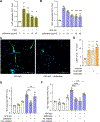Defibrotide Inhibits Antiphospholipid Antibody-Mediated Neutrophil Extracellular Trap Formation and Venous Thrombosis
- PMID: 34725956
- PMCID: PMC9050805
- DOI: 10.1002/art.42017
Defibrotide Inhibits Antiphospholipid Antibody-Mediated Neutrophil Extracellular Trap Formation and Venous Thrombosis
Abstract
Objective: Defibrotide is a heterogenous mixture of polyanionic oligonucleotides currently approved for treatment of transplant-associated venoocclusive disease. While defibrotide has a known role in limiting endothelial cell activation, some studies have also demonstrated anti-leukocyte properties. In a recent study, we found that neutrophil extracellular traps (NETs) play a role in the thrombotic complications of antiphospholipid syndrome (APS). In the present study, we investigated the hypothesis that defibrotide might act to mitigate APS-relevant NET formation in vitro and in mouse models.
Methods: We used in vitro assays and a mouse model to determine the mechanisms by which defibrotide inhibits NET formation and venous thrombosis in APS.
Results: At doses ranging from 1 to 10 μg/ml, defibrotide significantly suppressed NET formation from control neutrophils stimulated with IgG isolated from patients with APS. Defibrotide increased levels of intracellular cyclic AMP in neutrophils, and its suppressive effects on NET formation were mitigated by blocking adenosine A2A receptor or by inhibiting the cyclic AMP-dependent kinase protein kinase A. Defibrotide at doses ranging from 15 to 150 mg/kg/day inhibited NET formation and venous thrombosis in a model of antiphospholipid antibody-accelerated thrombosis-an effect that was reduced in adenosine A2A receptor-knockout mice.
Conclusion: This study is the first to demonstrate mechanisms by which defibrotide counteracts neutrophil-mediated thrombotic inflammation inherent to APS.
© 2021 American College of Rheumatology.
Figures


References
-
- Bertolaccini ML, Amengual O, Andreoli L, Atsumi T, Chighizola CB, Forastiero R, et al. 14th International Congress on Antiphospholipid Antibodies Task Force. Report on antiphospholipid syndrome laboratory diagnostics and trends. Autoimmunity reviews. 2014;13(9):917–30. - PubMed
-
- Brinkmann V, Reichard U, Goosmann C, Fauler B, Uhlemann Y, Weiss DS, et al. Neutrophil extracellular traps kill bacteria. Science. 2004;303(5663):1532–5. - PubMed
MeSH terms
Substances
Grants and funding
LinkOut - more resources
Full Text Sources
Medical
Miscellaneous

